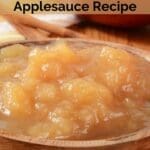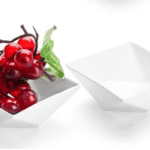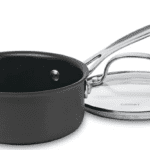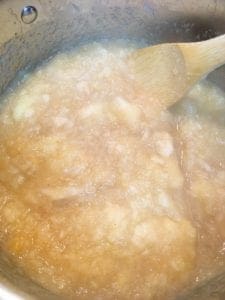Last updated on October 18th, 2024 at 03:48 pm
This homemade applesauce if full of flavor! Just the right amount of sweetness with a hint of cinnamon. I like to have a few apple pieces left in the mine. It just seems to make it more of a snack.
In the world of culinary delights, few things rival the simple, comforting taste of homemade applesauce. The fragrance of simmering apples, the gentle hint of cinnamon, and the velvety texture that dances on your taste buds.
It’s apple season
It’s a symphony of flavors that evokes warm memories of childhood and cozy family gatherings. Whether you’re an experienced chef or just venturing into the world of homemade delights, crafting your very own applesauce is a culinary adventure worth embarking upon.
No need for fancy gadgets or complex recipes; we’re all about embracing the beauty of simplicity here. Whether you have a bountiful harvest of apples from your orchard or simply picked up a bag of your favorite apples from the store, you’re just a few steps away from experiencing the joy of creating this classic treat from scratch.
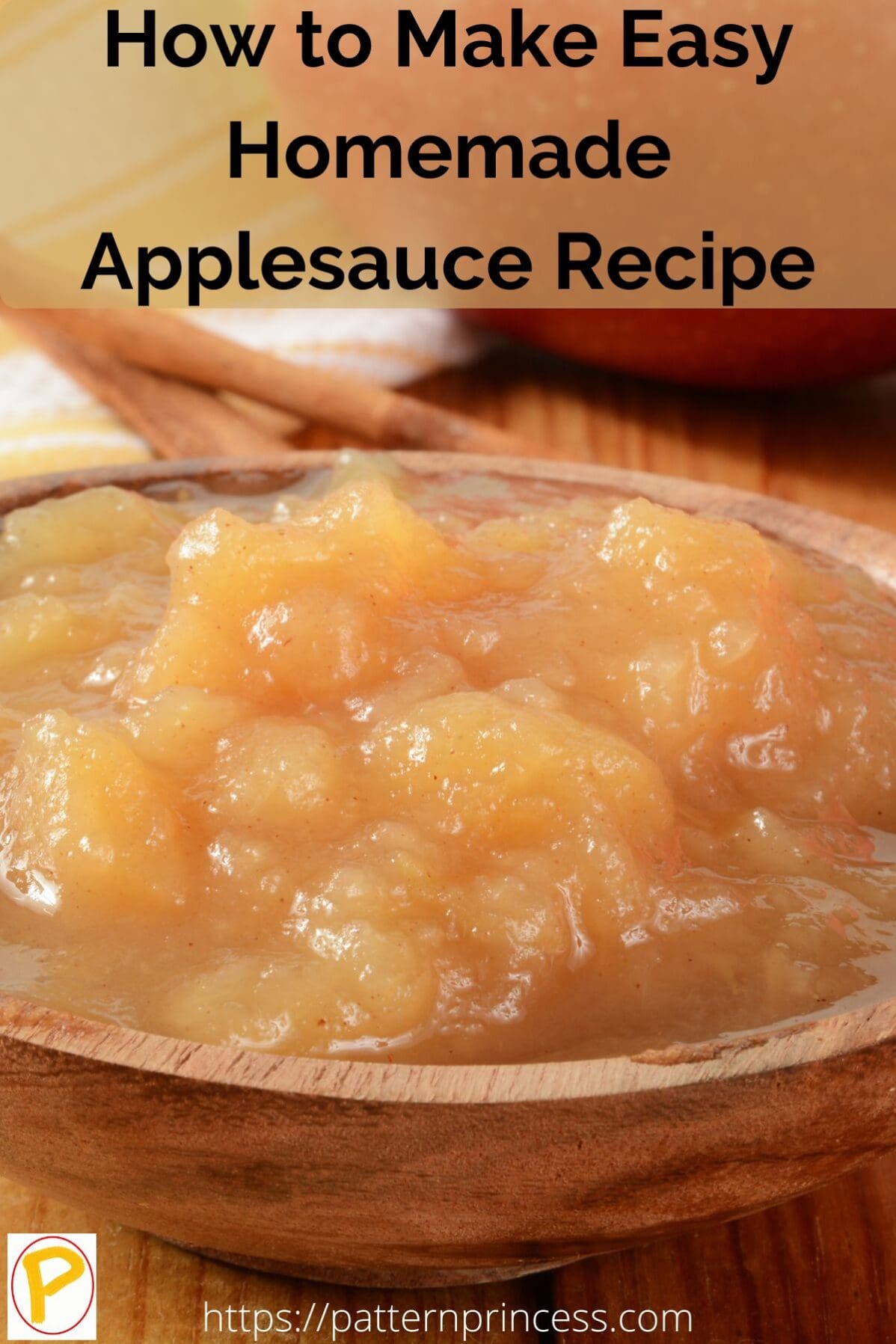
Post contains affiliate links, and we earn commissions if you shop through the links on this page. For more information, please read the disclosure section under the About Us page.
Homemade is Quick and Easy
The best applesauce recipe is so quick and easy, it can be made year-round with any type of apply you enjoy. Homemade is just so much better than canned applesauce.
This makes a great gift for the Holidays too.
Does homemade applesauce taste better?
You know exactly what has been put in your food. This fresh easy recipe for applesauce disappears quickly in our house.
Homemade applesauce often tastes better than store-bought varieties for several reasons.
Freshness
Homemade applesauce is typically made with fresh apples, which means you can select the ripest and best-quality apples available. This freshness can result in a brighter, more vibrant apple flavor compared to commercially processed applesauce.
Control Over Ingredients
When you make applesauce at home, you have full control over the ingredients. You can adjust the sweetness, choose your preferred apple varieties, and experiment with spices to create a flavor profile that suits your taste.
Mix different tastes for a varieties of apples. Make sure to include some sweet apples and tart apples for the best flavor.
No Preservatives or Additives
Many store-bought applesauces contain preservatives, additives, or excessive sugar. When you make applesauce at home, you can use minimal or no sugar, and you know exactly what’s in your sauce.
Homemade applesauce allows you to control the texture. Whether you prefer chunky or smooth applesauce, you can tailor it to your liking, ensuring a satisfying mouthfeel.
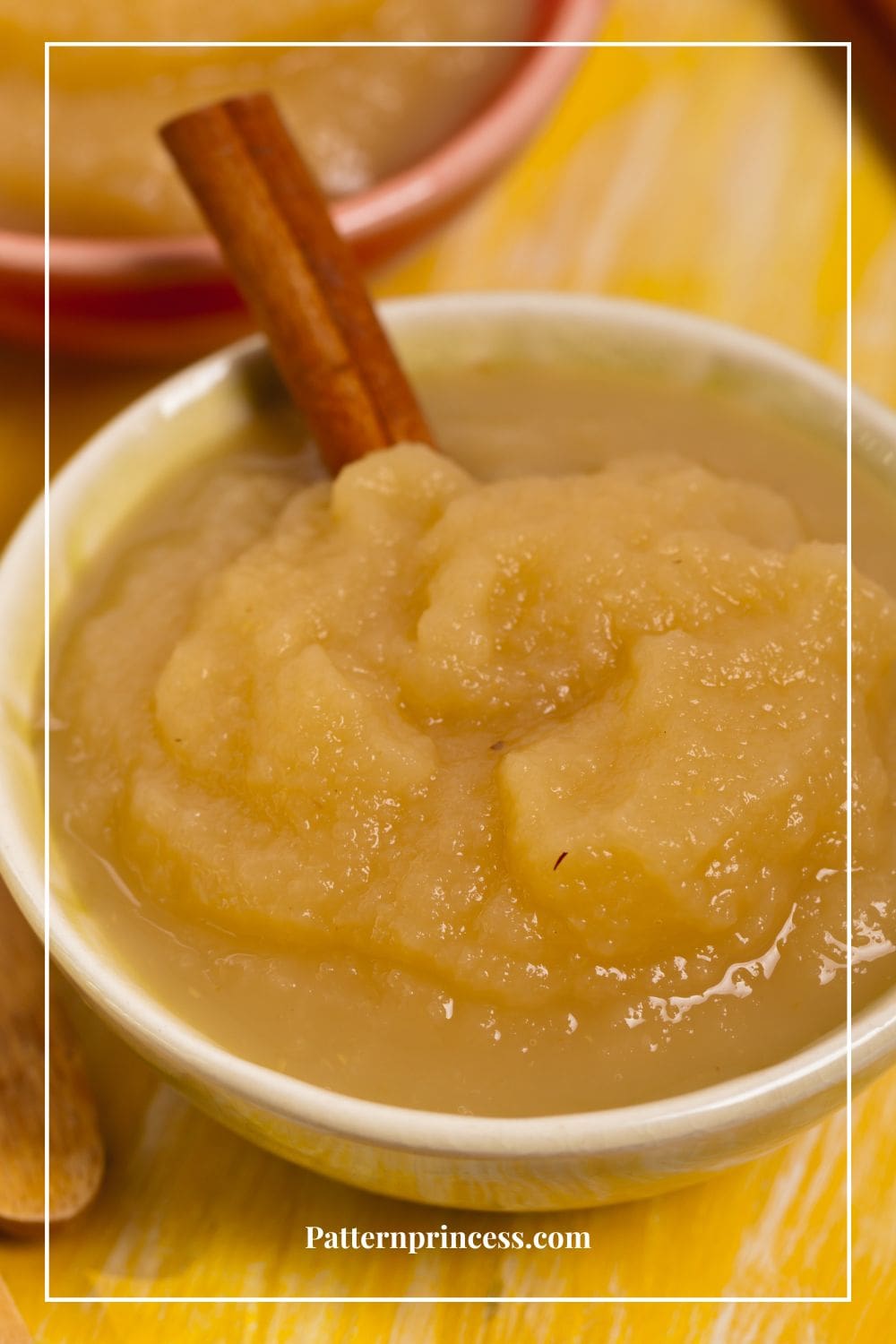
Customization To Your Liking
Homemade applesauce is highly customizable. You can experiment with different apple varieties and spices to create unique flavor combinations that cater to your preferences.
There’s a special satisfaction that comes from making something from scratch. Knowing that you’ve created a delicious sauce with your own hands can make it taste even better.
While homemade applesauce often has these advantages, taste preferences can vary. Some people may have a nostalgic attachment to a specific store-bought brand, while others appreciate the convenience of pre-made applesauce.
Ultimately, the “better” applesauce depends on your personal taste and the effort you’re willing to put into making it. Many people find the flavor and freshness of homemade applesauce to be a delightful treat, especially during the fall season when apples are at their peak.
How to Make Easy Homemade Applesauce Recipe
As an Amazon Associate I earn from qualifying purchases.
Kitchen Essentials
Ingredients
- 6 Cups Apples Peeled, cored, and chopped
- 1/2 Cup water
- 1 Tbl. Lemon Juice This helps keep the apples from discoloring
- 3/4 cup granulated sugar
- 1 Tsp. Ground Cinnamon
text ingredients
Instructions
- In a large saucepan, combine the apples, lemon juice, and water. Stir to coat. Cover and cook over medium-low heat for 20-25 minutes. Stirring every few minutes. The apples will be mostly mashed with a few chunks left yet.

- This is the stage where our family enjoys it. Add the sugar and the cinnamon; cook another 5 minutes. Cool and eat.

Your Own Private Notes
Notes
Nutrition
A few of my favorite things
The Power of Positivity

Homemade Applesauce Recipe Tips for Success
Creating a delicious homemade applesauce is easier than you might think, and it’s a delightful way to enjoy the flavors of fall. Here are some tips to ensure success with your applesauce recipe:
Choose the Right Apples. Not all apples are created equal when it comes to applesauce. Opt for varieties that are sweet and slightly tart, such as Honeycrisp, Fuji, or Granny Smith. A mix of apple varieties can also yield a more complex flavor.
Mixing Apples. Experiment with mixing a variety of apples helps balance flavors. For example, combine sweeter apples with tart ones to create a well-rounded taste. Such as granny smith apples, golden delicious apples, pink lady, fuji apples, or whatever kind are on your apple trees.
Peeling and Coring. While some recipes suggest leaving the skin on for added texture and nutrients, peeling and coring the apples usually results in a smoother applesauce. Use a good-quality peeler and apple corer for efficiency.
Equal-Sized Apple Chunks. Cut the apples into uniform-sized chunks to ensure even cooking. This will help prevent some pieces from turning mushy while others remain firm i while cooking in a large pot .
Add a Touch of Lemon. A splash of lemon juice not only brightens the flavor but also helps prevent the apples from browning. Use it sparingly to avoid overwhelming the apple taste.
Sweeteners and Spices. Taste your applesauce as it cooks and adjust the sweeteners and spices accordingly. Use sugar, honey, or maple syrup to sweeten. Add spices like cinnamon, nutmeg, or cloves for depth of flavor. Start with a little and add more as needed.
Simmer Slowly: Cooking the apples over low to medium heat allows the flavors to meld together beautifully. Frequent stirring helps prevent sticking and ensures even cooking.
Adjust The Texture Preference
Some people prefer chunky applesauce, while others like it smooth. You can use a potato masher for a chunkier texture or an immersion blender or a food processor for a smoother consistency. Remember that applesauce will continue to thicken as it cools. I don’t do either of these. When I am done cooking it, it’s done.
Enjoy It Fresh
While applesauce is delightful on its own, use it as a topping for pancakes, waffles, yogurt, or even as a side with savory dishes like roast pork or pork chops.
Making applesauce at home allows you to tailor the flavor and texture to your liking, so don’t be afraid to adjust the recipe to suit your taste preferences.
Applesauce As An Oil Alternative in Recipes
In many baking recipes applesauce can be used for part of the oil. Generally, when making quick breads, brownies, or cakes, half of the oil can be replaced with applesauce. I find that it gives the recipe a bit more moisture.
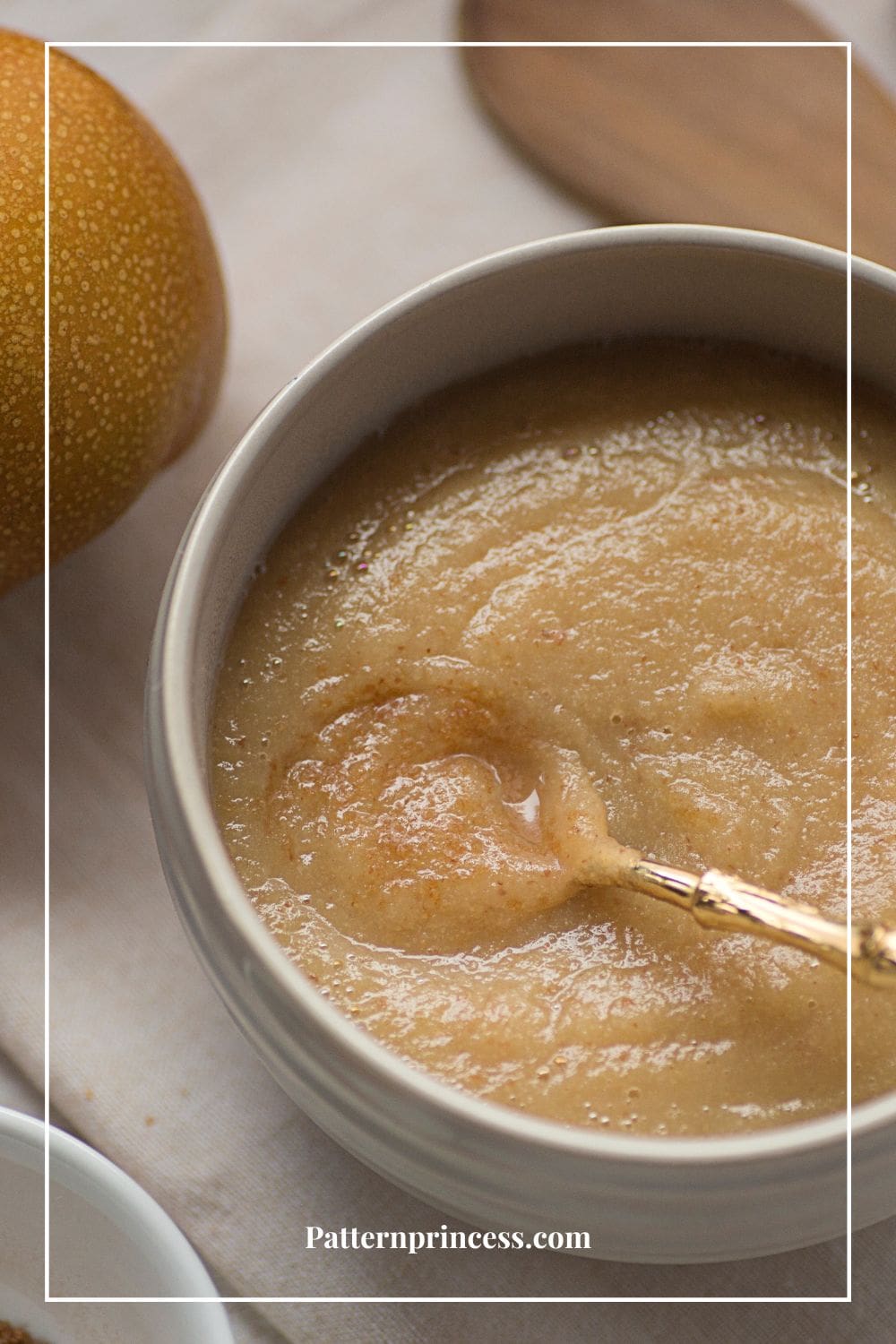
Why do you put lemon juice in applesauce?
It is best practice to add lemon juice for several reasons.
Flavor Enhancement. Lemon juice adds a bright, citrusy flavor to applesauce, which can help balance the sweetness of the apples. It provides a refreshing contrast and enhances the overall taste of the sauce.
Acidic Preservative. Lemon juice is acidic, and this acidity helps preserve the color of the applesauce by preventing the apples from oxidizing and turning brown. It acts as a natural preservative and helps maintain the sauce’s appealing appearance.
Freshness: The acidity of lemon juice can make the applesauce taste fresher and more vibrant. It can counteract any potential flatness in flavor that can occur when applesauce is made from cooked or canned apples.
Safety in Canning. When canning homemade applesauce for long-term storage, adding lemon juice can help increase the acidity of the sauce, making it safer for canning and reducing the risk of spoilage or bacterial growth.
Balancing Sweetness. Depending on the sweetness of the apples used and personal preferences, you may need to add sweeteners like sugar, honey, or maple syrup to your applesauce. Lemon juice can help cut through this sweetness and create a well-balanced flavor.
When adding lemon juice to applesauce, it’s important to use it in moderation to avoid making the sauce overly tangy or sour. A small amount of lemon juice, typically a few tablespoons for a large batch of applesauce, is usually sufficient to achieve the desired flavor and preservation benefits.
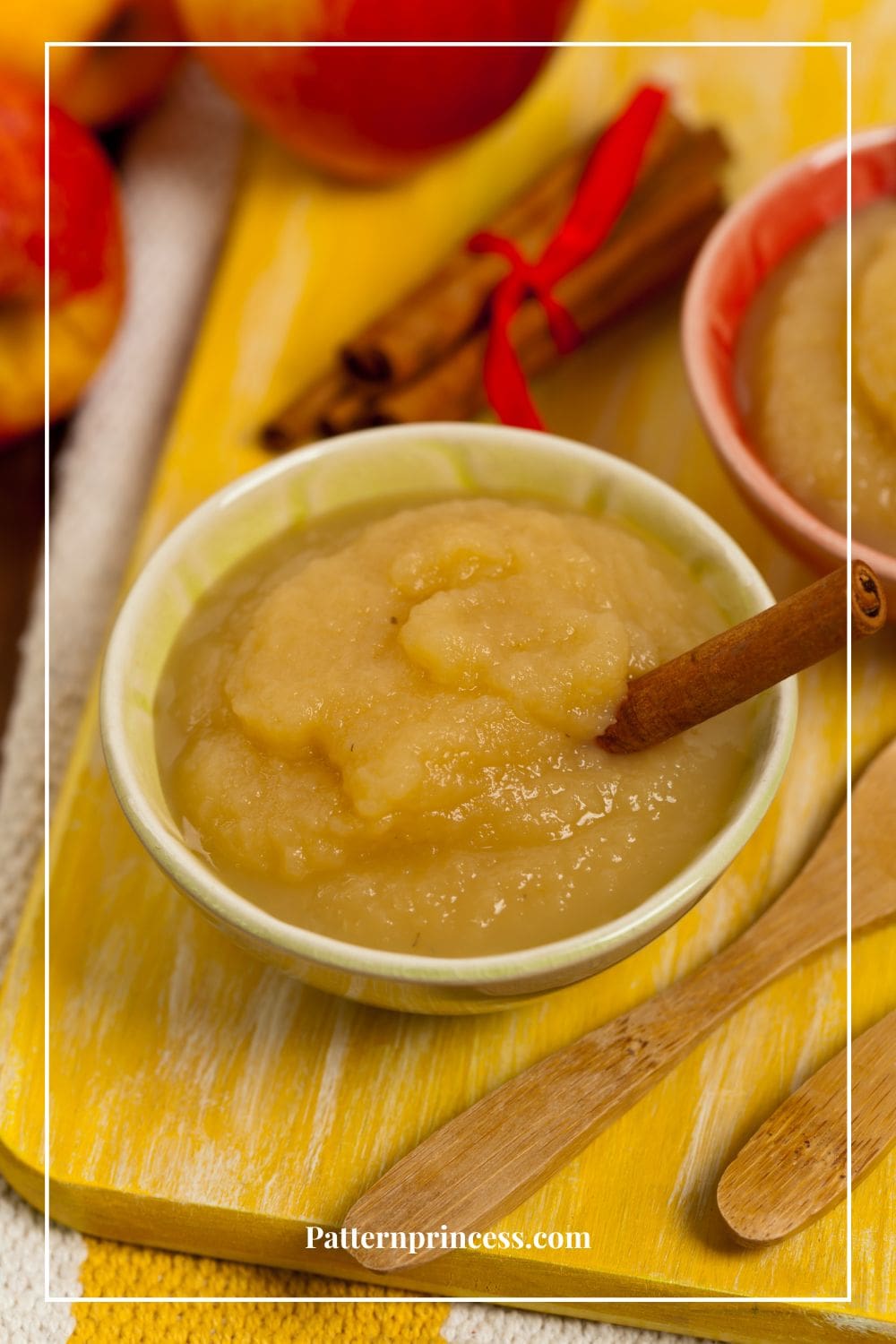
Why do you peel apples for applesauce?
Peeling apples for applesauce is a common practice for several reasons:
Texture and Consistency. Peeling apples ensures that your applesauce has a smoother and more consistent texture. The skin of apples can be tough and fibrous, and leaving it on can result in a chunkier or more uneven sauce, which some people may not prefer.
Aesthetics. Peeled apples create a visually appealing applesauce that is a uniform color and doesn’t have specks of skin throughout. This can be especially important if you’re making applesauce for presentation, such as for a dessert or as a topping.
Removal of Impurities. Peeling apples allows you to remove any impurities, dirt, or pesticide residue that may be on the skin. This is particularly important if you’re using apples that haven’t been thoroughly washed or if you’re using apples from an unknown source.
Consistent Flavor. Apple skins can have a slightly bitter or tart taste, and removing them can result in a sweeter and more purely apple-flavored sauce. This is especially relevant if you’re making unsweetened applesauce or if you want to control the level of sweetness in your sauce.
Digestibility. Some people may find that peeled apples are easier to digest, especially if they have digestive sensitivities or dietary restrictions.
While peeling apples for applesauce is a common practice, it’s not strictly necessary. Some recipes and personal preferences allow for leaving the skin on, and this can add a rustic, textured element to the sauce.
Whether or not to peel apples for applesauce ultimately comes down to your personal taste and the texture you desire in your finished product.
How long does applesauce last
The shelf life of applesauce depends on various factors, including whether it’s homemade or store-bought, how it’s stored, and whether any preservatives are used. Here are some general guidelines:
Homemade Applesauce:
- Refrigerated. Homemade applesauce can typically be stored in the refrigerator for about 1 to 2 weeks. It should be kept in an airtight container to prevent moisture loss and contamination.
- Frozen. If you want to extend the shelf life, you can freeze homemade applesauce. When stored in an airtight container or freezer-safe bag, it can last for 6 months to a year in the freezer. Be sure to leave some space at the top of the container or bag to allow for expansion as the sauce freezes.
Store-Bought Applesauce:
- Unopened. Commercially processed and sealed applesauce in jars or cans can have a shelf life of 1 to 2 years or even longer. It should be stored in a cool, dark place, away from direct sunlight and extreme temperatures.
- Opened. Once a store-bought applesauce container is opened, it should be refrigerated and consumed within 1 to 2 weeks. Always check the label for any specific instructions provided by the manufacturer.
Applesauce can go bad, It is a good practice to use your judgment and your senses sight, smell, and taste. Look for any signs of spoilage, such as an off odor, mold growth, or an unusual appearance, it should be discarded.
Freeze Applesauce
Applesauce freezes well. Just place into airtight containers or a freezer bag and freeze. Label the containers so you know what is inside and when you placed it in the freezer. It will last up to 6 months.
Canning Your Applesauce
You can use this recipe for canning homemade applesauce for long-term storage. Just follow proper canning techniques and guidelines is crucial to ensure its safety and extend its shelf life. Canned applesauce can last for up to 1 to 2 years or more when stored in a cool, dark place. Always consult reputable canning resources for detailed instructions on safe canning practices.
If you still have some apples left, this Apple Coffeecake with Cinnamon Cake is delicious and easy to make.
Make this Applesauce in a Slow Cooker
Making applesauce in a slow cooker is a convenient and hands-off method that results in delicious, homemade applesauce. Here’s a basic recipe to guide you through the process.
Place the sliced apples in the slow cooker.
Add water or apple juice to the slow cooker to provide moisture for cooking. The exact amount may vary depending on the moisture content of your apples and your desired sauce thickness. Start with 1/2 cup and adjust as needed.
Sprinkle the sugar, cinnamon, and any optional spices (nutmeg, salt) evenly over the apples.
If you’re using lemon juice, drizzle it over the apples. Lemon juice adds flavor and helps prevent browning.
Gently stir the ingredients to distribute the sugar and spices among the apples evenly.
Crockpot Applesauce Cooking Time
Cover the slow cooker with its lid and cook on low heat for 4 to 6 hours. The cooking time may vary depending on your slow cooker and the type of apples you use. Check the apples periodically, and stir if necessary.
Adjusting the Chunkiness
Once the cooked apples are very soft they can easily be mashed with a fork. You can use a potato masher for chunky applesauce or a food mill or immersion blender for a smoother consistency.
Taste and Adjust: Taste the applesauce and adjust the sweetness and spice levels if necessary. You can add more sugar or cinnamon to suit your taste.
I hope that you liked this recipe. If you are looking for more ideas on what to make, here are a few other apple recipes and more that you may enjoy.

You can find Victoria crocheting, quilting, and creating recipes. She has cooked in restaurants for over 20 years, including many larger parties. She learned to crochet when she was just 11 years old and has been crocheting ever since; over 50 years now. Over 40 years ago, she loved her first class in sewing and continues to hone her skills in quilting. Many have enjoyed the handmade gifts over the years. In her professional career, she has worked in management in a wide variety of businesses including higher education as a dean of a division. All the while attending college part-time to achieve her doctorate in higher education with an emphasis in e-learning.

